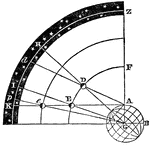Clipart tagged: ‘Parallax’

Annual Parallax
"Suppose a to be a stationary celestial object, then as the Earth makes her annual revolution around…

Diurnal Parallax
"If we suppose a spectator placed at G, in the Earth's center, he would see the moon E, among the stars…